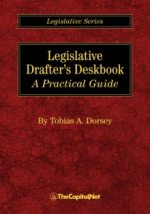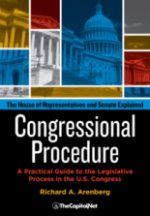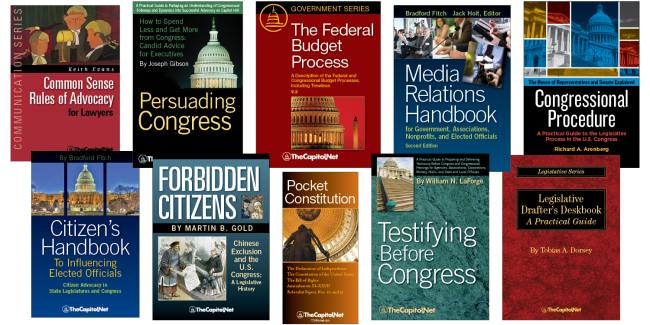From the Congressional Glossary – Including Legislative and Budget Terms
Quorum

Quorum, n. A sufficient number of members of a deliberative body to have their own way and their own way of having it. In the United States Senate a quorum consists of the Chairman of the Committee on Finance and a messenger from the White House; in the House of Representatives, of the Speaker and the Devil.
– Ambrose Bierce, The Devils Dictionary
The minimum number of members whose presence is necessary for the transaction of business. In the Senate and House, it is a majority of the membership. U.S. Constitution, Article. I. Section. 5. Both chambers usually assume a quorum is present even if it is not. If a point of order is made that a quorum is not present, the only business that is in order is either a motion to adjourn or a motion to direct the sergeant-at-arms to request the attendance of the absentees.
The number of senators that must be present for the Senate to do business. The Constitution (Article. I. Section. 5.) requires a majority of senators (51) for a quorum. Often, fewer senators are actually present on the floor, but the Senate presumes that a quorum is present unless the contrary is shown by a roll call vote or quorum call.
A quorum in the House of Representatives is when a majority of the Members are present. When there are no vacancies in the membership, a quorum is 218. When one or more seats are vacant, because of deaths or resignations, the quorum is reduced accordingly. Because of Members’ other duties, a quorum often is not present on the House floor. But any Member may insist that a quorum must participate in any vote that takes place in the House. If a Member makes a point of order that a quorum is not present, and the Speaker agrees, a series of bells ring on the House side of the Capitol and in the House office buildings to alert Members to come to the chamber and record their presence. A quorum is 100 in the Committee of the Whole House.
Quorum – Do I Love You?
Individual committees set their own quorum requirements to conduct a hearing. However, House rules require that not fewer than two members be present. Senate committees usually allow a single senator to be present to conduct a hearing. Individual House committee rules also set a quorum requirement for waiving a hearing notice, but House rules disallow the quorum from being less than one-third. Senate committees have no comparable rule. Finally, for House committees, a majority of members of a committee constitutes a quorum for authorizing a subpoena or closing a committee session. Most congressional committees allow ex officio members to be counted toward establishing a quorum.
Also see
- Cloture
- Committee of the Whole
- Filibuster
- Quorum Call (Congressional Glossary)
- § 6.40 Committee Hearings, § 6.112, House versus Committee of the Whole, § 6.130 House Floor: Voting, and § 6.250 Voting in the Senate, in Congressional Deskbook
- in Congressional Procedure
- Chapter 1.C. Rules
- Chapter 1.E. Members of Congress
- Chapter 2.H. Simple Resolutions
- Chapter 3.E. Markups
- Chapter 3.G. Reporting Legislation to the Floor
- Chapter 4.A. Introduction
- Chapter 4.F. Motion to Suspend the Rules
- Chapter 4.I. Voting
- Chapter 5.G. Quorum Calls
- Chapter 5.H. Filibuster
- Chapter 5.M. Voting
- Chapter 6.G. The President
- Chapter 8.B. Nominations
- Chapter 8.D. Treaties
- Chapter 8.G. Impeachment and Trial
- Chapter 8.M. Rulings and Appeals of Rulings of the Chair
- Chapter 8.R. Amending the Constitution
More
- House Rule XX – Voting and Quorum Calls
- Senate Rule VI – Quorum-Absent Senators May Be Sent For
- “Quorum Requirements in the House,” CRS Report 98-870 (7-page PDF
 )
) - “Quorum Requirements in the Senate,” CRS Report 98-775 (4-page PDF
 )
) - “Voting and Quorum Procedures in the Senate,” CRS Report 96-452 (16-page PDF
 )
) - “Quorums in House Floor Proceedings,” CRS Report 97-704 (7-page PDF
 )
) - “The Legislative Process on the Senate Floor: An Introduction,” CRS Report 96-548 (20-page PDF
 )
) - “The Legislative Process on the House Floor: An Introduction,” CRS Report 95-563 (18-page PDF
 )
)
Courses
- Congressional Operations Briefing – Capitol Hill Workshop
- Drafting Federal Legislation and Amendments
- Writing for Government and Business: Critical Thinking and Writing
- Custom Training
- Drafting Effective Federal Legislation and Amendments in a Nutshell, Audio Course on CD
- Congress, the Legislative Process, and the Fundamentals of Lawmaking Series, a Nine-Course series on CD
Publications
CongressionalGlossary.com, from TheCapitol.Net
For more than 40 years, TheCapitol.Net and its predecessor, Congressional Quarterly Executive Conferences, have been teaching professionals from government, military, business, and NGOs about the dynamics and operations of the legislative and executive branches and how to work with them.
Our custom on-site and online training, publications, and audio courses include congressional operations, legislative and budget process, communication and advocacy, media and public relations, testifying before Congress, research skills, legislative drafting, critical thinking and writing, and more.
TheCapitol.Net is on the GSA Schedule, MAS, for custom on-site and online training. GSA Contract GS02F0192X
TheCapitol.Net is now owned by the Sunwater Institute.
Teaching how Washington and Congress work ™





